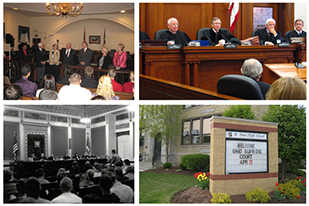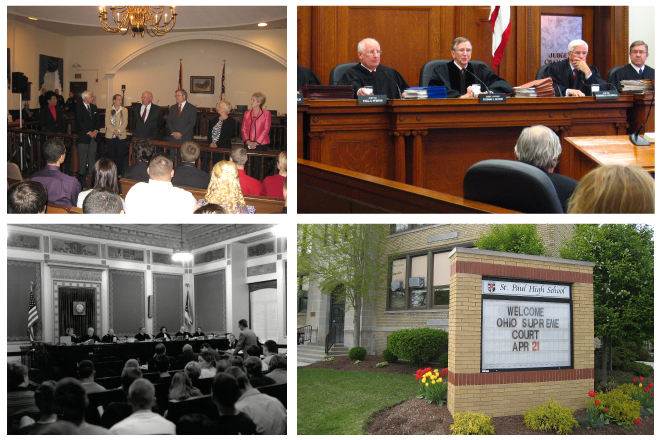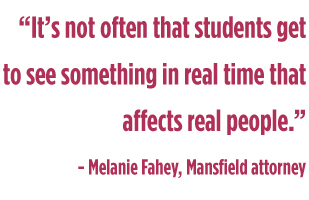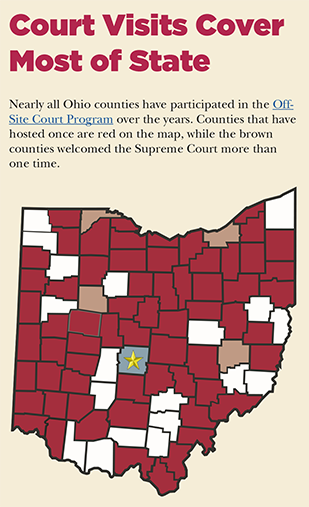Robes on the Road
The Ohio Supreme Court didn’t step tentatively into its Off-Site Court Program. At launch, the Court scheduled seven sessions in 18 months outside of its Columbus courtroom. That bold start began in 1987 – 30 years ago this October – and was spearheaded by the late Chief Justice Thomas J. Moyer.
The chief justice had entered office only that January, but he wanted to enhance student knowledge about Ohio’s judicial system by taking the Court directly to the schools and their communities, said Ruthie Newcomer, who coordinated the effort in those early years. Newcomer explained that Chief Justice Moyer once served as Columbus school board president, following in the footsteps of his father, who held the same role in Sandusky.
“Education was a huge priority for Chief Justice Moyer,” she said.
The Court organized the inaugural off-site session in Marietta, which in 1987 was celebrating 200 years since becoming the first permanent settlement in the Northwest Territory. The tradition of the Supreme Court traveling to different locations across the state continues today. To commemorate the program’s 30th anniversary, the Supreme Court returns to Marietta on Oct. 18 to hear oral arguments in front of hundreds of high school students at Marietta High School.

A look back at a few off-site sessions of the Ohio Supreme Court (left to right): Highland County, 2011; Knox County, 2007; Mercer County, 1998; and Huron County, 2010.

A look back at a few off-site sessions of the Ohio Supreme Court (left to right): Highland County, 2011; Knox County, 2007; Mercer County, 1998; and Huron County, 2010.
Much goes into planning a session involving seven justices and crowds of students, from security, lodging, and food for the justices to coordinating the flow of students through the Court’s session and preparing them ahead of time for the experience. Court officials, teachers, and attorneys who’ve arranged past off-site court sessions said that it’s a community gathering well worth the work, with many noteworthy benefits.
Bringing Court to Life
As part of the Court’s civic education outreach, the Off-Site Court Program targets high school students to build understanding about how the Ohio Supreme Court, and the state’s judicial system in general, operates. The bench and bar in local communities invite the Supreme Court to their county for an off-site session, and to date 68 counties have hosted the Court.
When Morgan County prepared for the visit from the Supreme Court earlier this year, Morgan High School Principal Anita Eldridge began with the basics. Teachers and staff discussed with students the appropriate behavior for the formality of a court proceeding and practiced entering and exiting the auditorium that would be transformed into a courtroom.
In the weeks leading up to every off-site court session, students study the judicial system’s different levels and the specific cases they will hear argued before the Supreme Court. They are helped by their teachers and local attorneys who volunteer their time to attend classes to delve into the background of the scheduled cases.
Eldridge said that for many of her students a trip to Zanesville, approximately 30 miles from the high school in rural McConnelsville, would be a major event.
“The visit from the Supreme Court made the students feel special,” she said. “And seeing court for themselves is a good way to make it real, to help students get a better understanding, and more appreciation, of what happens in the judicial system.”


Melanie Fahey, a Mansfield attorney who was a magistrate when she worked with students in Richland County for the Ohio Supreme Court’s March 2015 session there, agreed. At their age, high school students have experienced a lot of “mock” things, such as mock trials or mock car crashes in driver’s education, Fahey noted.
“It’s not often that students get to see something in real time that affects real people,” she said.
Students tend to have a fundamental grasp of their rights in a criminal setting, but have little exposure to the appeals process or civil litigation, she said. She added that, as part of the process, students learned that legislation passed by the General Assembly isn’t the only type of law.
“Without personal involvement, it’s hard for them to understand the appellate process, the concept of precedent, and the effect of court decisions on others down the road,” she said. “If you experience it, you will retain it.”
Distinctive Learning Opportunity
Richland County Common Pleas Court Administrator Tammy Wurthmann, who enlisted Fahey’s help for the event, noted that all the county’s high schools – 11 in total – attended the Supreme Court’s session, which she described as a “unique educational experience.”
“The attorney educators and I liked, appreciated, and were surprised by the students’ attention and enthusiasm,” Wurthmann said.
Other organizers across the state repeated the positive impression the Supreme Court session and educational activities made on their students. Debbie Weiskittle, court administrator for Logan County Common Pleas Court, oversaw the details when the county hosted an April 2013 off-site court event. She also had the unenviable task of shifting the event from the courthouse to the Distance Learning Center at Bellefontaine High School after a severe windstorm damaged the courthouse. Weiskittle mentioned that unlike some other local public-service-oriented events that didn’t always draw high interest from youth, the Supreme Court’s session seemed to strike a different chord.
“Once students saw the Court’s session, they found it’s not like TV. This is the real thing, what the law involves,” Weiskittle said. “Students didn’t understand beforehand the magnitude of the event.”


“Many kids don’t see the positive sides of the law,” Judge Paula Giulitto of the Portage County Domestic Relations Court noted. She helped organize the Supreme Court’s September 2014 visit at Ravenna High School and valued the occasion so much that she called each school in the county.
“I wanted every student to be invited and to have a chance to participate,” Judge Giulitto said. “For those students, this was a once-in-a-lifetime opportunity.”
The Portage County off-site court drew one of the highest-ever crowds – about 1,000 high schoolers from 12 schools. Fortunately, she said, Ravenna had a new and large high school with an auditorium and two gyms to accommodate the movement of the students through the event.
Many High Points
Highland County welcomed the Supreme Court in 2011, when it heard the constitutional challenge to the state’s new law banning smoking in public places. Judge Rocky Coss, who helped plan the event, was surprised by the community’s response. Many in the public called, asking to attend, Judge Coss said. The court was able to accommodate dozens of people alongside the students. He recounted that a successful local businessman even took his grandson out of school to participate.
“He knew it would be very educational, it was a historic occasion, and it may never happen again,” Judge Coss said.
Judge Giulitto said she especially appreciated the question-and-answer, unscripted discussion that the justices have with students before Court begins. Each justice delivered a brief personal history, including fun nuggets such as one who worked at McDonald’s, the judge noted. She was impressed by the justices’ candor when talking with students and the youths’ respect toward the justices.
“The exchange was amazing, and greatly impacted the students,” she said.
Fahey highlighted the “debriefings” after the Court’s session, when the attorneys who argued the cases discuss with the students the oral arguments and the legal points. It’s not often that students have the opportunity to talk at length about an educational experience like this, she said, and she was surprised and impressed by the insightful questions the students asked.
“They wanted to understand what the issues were and why they were still in dispute,” Fahey noted. “They got inside issues that are complex for lawyers. The program added a richness to the students’ understanding of how their legal system works.”
Conversation Continues
After the Supreme Court headed home, court officials and educators found themselves inspired to keep the productive dialogue going between courts and youth. Wurthmann said teachers asked if Richland County Common Pleas Judge Brent Robinson would take time to speak with students. Now their court hosts a couple groups of students once a year for a Q&A. Wurthmann brings in the judge, jail staff, attorneys, and probation officers to answer student questions.
![Image of the Debbie Weiskittle quote '[Off-site court] is the real thing, what the law involves. Students didn't understand beforehand the magnitude of the event.'](/happening/2017/images/weiskittleQuote_101717.jpg)
![Image of the Debbie Weiskittle quote '[Off-site court] is the real thing, what the law involves. Students didn't understand beforehand the magnitude of the event.'](/happening/2017/images/weiskittleQuote_101717.jpg)
The same happened in Portage and Highland counties, Judges Giulitto and Coss said. The local bar association in Portage County identified guest speakers from the legal field to periodically visit schools and talk with students. Youth in Highland County regularly tour its historic common pleas courthouse and have the opportunity to sit in on court hearings.
Judge Coss thinks it’s important to bring state government to the people. Not only does the public learn from seeing courts in action, but they might take judicial elections more seriously and be more likely to cast votes for judges, he said, referring to the drop-off of voting down ballot.
“The program is such a win-win for everyone,” Newcomer said. “We need so much education about the judicial branch of government. Off-site court is a significant step in raising that awareness.”


